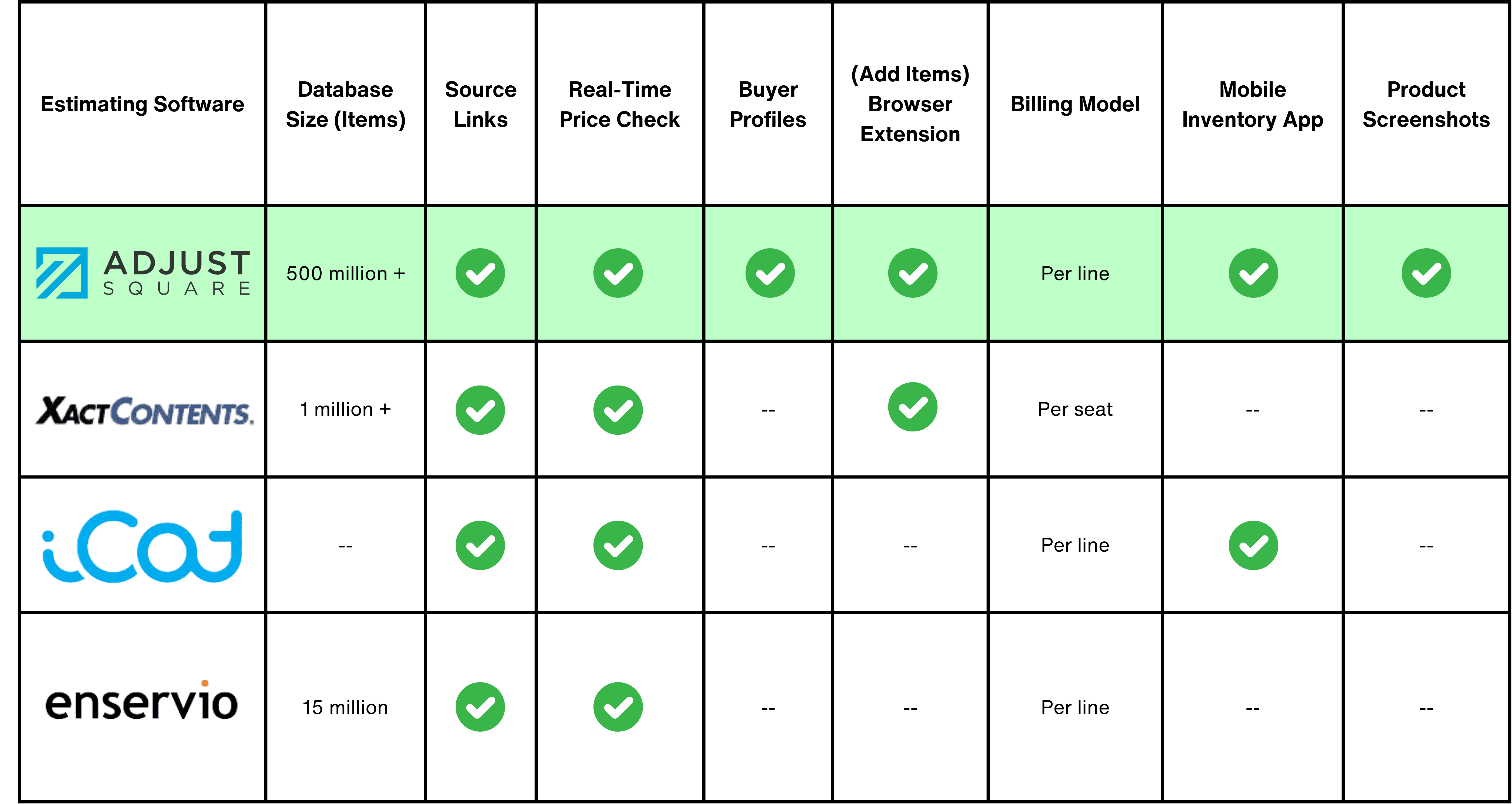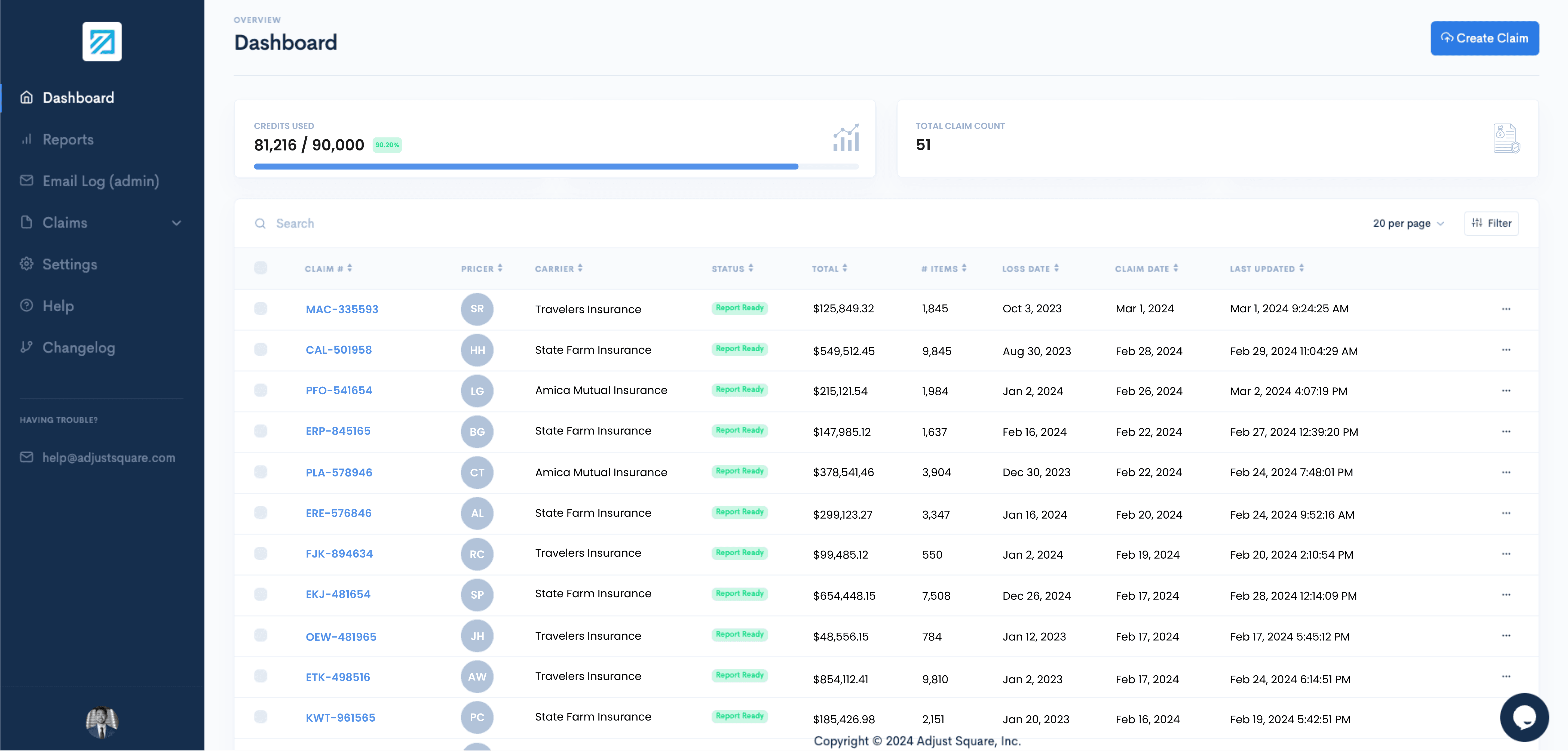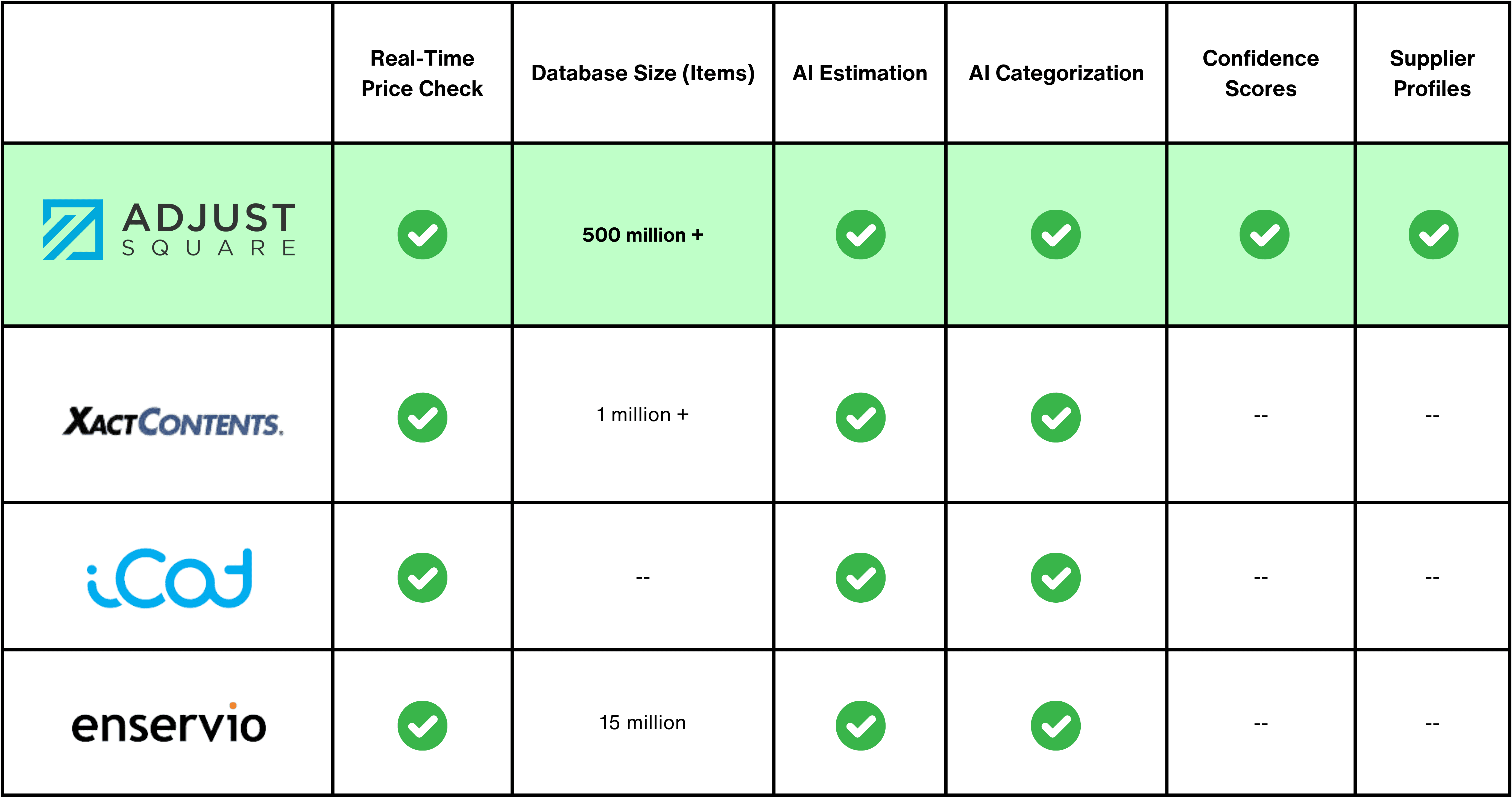
Comparing The Best Insurance Estimating Software in 2024
Comparing The Best Insurance Estimating Software in 2024
Comparing The Best Insurance Estimating Software in 2024
In 2024, the top 4 software solutions for residential contents estimations in insurance include a hybrid of desktop and web-based options.
In 2024, the top 4 software solutions for residential contents estimations in insurance include a hybrid of desktop and web-based options.

Nathan Koo
Nathan Koo
Jul 12, 2024
Jul 12, 2024
9 mins
9 mins



The Difficulties of Contents Estimation
As the new year begins, businesses like yours are setting new goals and looking to improve your operations.
Whether you're an...
independent adjusting firm (IA)
public adjusting firm (PA)
restoration company
estimating firm
or carrier...
you're always looking for new ways to increase efficiency and customer satisfaction when it comes to contents estimation.
Numerous individuals are encountering challenges when it comes to estimating contents. Their teams are putting in extensive efforts to overcome these estimation bottlenecks, relying on manual tasks to meet the current demands. They are eagerly awaiting advanced technology and software solutions to effectively address these efficiency issues. This leads us to wonder:
What specifically is estimating software?
How can a good estimating software address your current and future estimation challenges?
What is Estimating Software? What are it's Benefits?
Insurance estimating software enables estimators to efficiently and accurately determine the value of residential claim inventories. Estimating software varies among vendors in terms of speed, accuracy, cost, connectivity, and ease of use. In the comparison below, we will discuss each of these metrics. Here is a brief explanation of each metric:
Speed
Speed refers to how much faster you can estimate items using this estimating software and, as a result of this:
How many more items you are able to estimate over a given period of time.
Accuracy
Accuracy is the most crucial metric when it comes to estimating software. It determines how trusted andprecise the prices provided by the software are. During the settlement negotiation with the insured, having an accurate estimate plays a significant role in saving time and minimizing the need for review and correction.
Cost
It is important to understand the pricing model of the vendor and what they charge as it can impact the user's overall expenses. Utilizing estimating software introduces a new variable cost that may not have been present before, so it is essential to consider its implications on the bottom line.
Connectivity
Estimation is just one component of the overall claim cycle. It is important to consider the connectivity of the estimating software with existing claims management systems and its ability to integrate with inventory solutions. By integrating the inventory and estimation steps, there is no need to transfer claim information between different systems. This seamless integration reduces friction for users as they navigate through the claim management process.
Ease of Use
Estimating software is often known for its steep learning curve, which can be overwhelming for beginners. It is crucial to carefully evaluate the intuitiveness and user-friendliness of the estimating software to ensure a smooth adoption process.
Alternatives to Estimating Software
Before we dive into a comparison of the top estimating software vendors, it's important for us to also consider the alternatives to estimating software:
Third-party estimation firms and services
Manual estimation
No estimation
Third-Party Estimation
You send an inventory list to a third-party estimator and they produce a contents estimate for you.
Pros:
Out of sight out of mind: You don't need to perform any estimation work yourself.
You don't need to manage or maintain payroll and benefits for an in-house estimation team.
Cons:
Expensive because you are paying an additional cost for someone else to perform the estimation work.
Turnaround times vary and can be extremely lengthy based on how "at-capacity" the vendor is.
Manual Estimation
You perform an estimate by hand using a combination of Google search, a spreadsheet, and/or pen and paper.
Pros:
No additional costs outside of paying yourself and an in-house group of estimation staff.
Cons:
You need to manage and maintain payroll for an in-house estimation team.
The slowest method of contents estimation.
No Estimation
You make an informed but general estimate on the value of the insured's contents based on key demographic information.
Pros:
Not estimating each individual line item results in the fastest claim turnaround time.
Cons:
Often results in significant inaccuracies, resulting in poor customer satisfaction as well as potential overpayment.
Inappropriate in many insurance policies based on jurisdiction and specific policies of a carrier.

Summarizing Key Providers of Estimation Software
Upon careful analysis of the alternatives to estimating software, a consensus often emerges that incorporating technology into the estimation process is the best solution. Currently, there are four leading vendors of estimating software in the homeowner's contents space (in no particular order):
Adjust Square
XactContents
iCat Fast LKQ
Enservio
None of these software are "one-size fits all". The decision to choose one over the other is based on best fit and need.
1. AI Estimator by Adjust Square
AI Estimator transforms the role of an estimator by transitioning them into reviewers. With every item that is uploaded, AI Estimator conducts a thorough search through a vast database of over 500 million retail products available online, providing a curated selection of approximately 10 of the most precise and reliable results to choose from. It then selects what it believes to be the best match for your input item.
The entire estimation process can be completed in minutes:
The entire inventory list is uploaded, and AI Estimator efficiently finds multiple replacement item options for each item.
It then selects the most accurate replacement while providing a confidence score.
Additionally, source links and screenshots are taken for each replacement item to enhance the accuracy of your estimate.
The estimator now has the convenience of entering the claim, filtering items flagged as 'low confidence' by AI Estimator, and reviewing them. This significantly reduces their workload, as AI Estimator accurately estimates most items. Upon completion, the estimator can easily download a customizable estimation report with just a single click.
AI Estimator stands out as the fastest and most comprehensive contents estimating software today, as it directly searches and selects accurate product replacements. Additionally, it provides source links, product screenshots, and a downloadable estimation report, ensuring a seamless and efficient estimation process.

AI Estimator's home dashboard offers a seamless experience for managing estimates. Take instant action on your estimates, gain valuable insights from statistics, and effortlessly generate new estimates.
Pros:
Quick estimates: AI Estimator efficiently completes a large portion of an estimator's work, allowing them to handle more inventories per day and focus on more challenging items.
High accuracy: It pulls data directly from a database of over 500 million trusted online retail products, including suppliers like Walmart, Amazon, and Best Buy.
Credible: Provides source links and product screenshots for all estimated items, enhancing the credibility of your estimates and saving you time.
Modern, easy-to-learn user interface: Even new users can be trained within just thirty minutes.
No need for personally identifiable information (PII): The software can be seamlessly integrated into various use cases without requiring sensitive personal data.
Responsive customer support: Any questions are addressed promptly through live chat.
Volume discounts: Pricing includes discounts for larger volumes of estimates.
Cons:
Not currently integrated with major CMS's.
Does not perform any estimations outside of residential contents (e.g. roofing, construction costs, etc.)
Best Fit:
Individuals or businesses involved in extensive contents estimation who are experiencing challenges in estimation and seeking to expand their inventory and/or estimation operations.
2. XactContents by Verisk
XactContents is the longest-tenured estimating software in the industry and is highly regarded for its direct integration with Xactimate, the leading software for structural estimates and restoration professionals. Unlike the other software mentioned, which solely focus on contents estimation, XactContents and Xactimate offer a comprehensive solution for handling the entire property claim process.
Pros:
Connects directly to Xactimate: You can have your entire claim consolidated and managed under one system.
Charges per seat, which is generally more cost-effective when working on large claims.
Cons:
Product selections and categorizations are inaccurate, requiring significant time spent on review.
Product catalog is limited and contains only three prices for each product: low, average, high.
Interface is dated and overwhelming, often requiring a significant amount of training to begin using.
Best for:
Smaller teams of restoration professionals and contractors who are looking to get started in property restoration and estimates.
3. iCat Fast LKQ
The Fast LKQ software by iCat is specifically designed for restoration companies that specialize in the cleaning, restoration, and repair of contents. It serves as an inventory and project management software that seamlessly integrates with the iCat mobile inventory app, providing a comprehensive and efficient inventorying experience.
The iCat main system handles the inventorying and restoration of contents
iCat Fast LKQ is billed on a per-item basis and is specifically designed for contents estimation.
Pros:
Prioritizes inventorying, inventory management, and the effective management of inventory restoration.
An excellent software tool for capturing images, documenting, and efficiently managing the status of inventory items.
The interface exhibits a slightly more contemporary design compared to older estimating software, resulting in a less overwhelming experience on average.
Cons:
Not the fastest or most accurate estimating software.
Has stated that their tool requires significant training and practice to use.
Best for:
Individuals or businesses involved in extensive inventorying tasks and have additional requirements for managing contents restoration.
Canadian clients (iCat is based in Canada).
4. Contents Express by Enservio
Enservio not only developed their own estimating software but also offers estimation services that utilize their software. However, adjusters have reported a fast turnaround time but lower accuracy rates when using their estimation service, as many line items require edits. This might be attributed to their relatively smaller product database of only 15 million products.
Pros:
Offers an estimation service that eliminates the need for users to perform their own estimates.
The estimation service boasts a relatively fast turnaround time, as Enservio utilizes their own estimating software.
Cons:
Costly per-item rate as you are compensating for the services provided by someone else.
Lower accuracy rates, most likely stemming from a smaller database of only 15 million products.
Best for:
Organizations that prefer not to handle the management and maintenance of an in-house estimation team.
Firms who are willing to invest a significant amount of money in estimations to avoid performing them in-house.
Here is a summary table that provides a quick comparison of the most important AI features when selecting an estimating software:

Conclusion
This blog post provides a comprehensive guide to help you in your search for new estimating software to accurately estimate residential contents.
Here's what you have learned so far:
The definition of estimating software.
The advantages of using estimation software.
The factors to consider when searching for estimating software.
The alternatives to using estimation software.
The top 4 estimating software vendors in the industry as of 2024 and how they vary based on user requirements.
The insurance industry is rapidly embracing new technologies every day. The innovative solutions and products you envisioned years ago are now becoming a reality, offering immense potential to enhance and expand your business. With a wide range of options available, the ultimate decision depends on your specific needs and goals.
If you're currently facing a significant contents bottleneck and want to overcome this, reach out to Adjust Square today. We can provide you with a personalized assessment and tailored solution to address your challenges with contents.
The Difficulties of Contents Estimation
As the new year begins, businesses like yours are setting new goals and looking to improve your operations.
Whether you're an...
independent adjusting firm (IA)
public adjusting firm (PA)
restoration company
estimating firm
or carrier...
you're always looking for new ways to increase efficiency and customer satisfaction when it comes to contents estimation.
Numerous individuals are encountering challenges when it comes to estimating contents. Their teams are putting in extensive efforts to overcome these estimation bottlenecks, relying on manual tasks to meet the current demands. They are eagerly awaiting advanced technology and software solutions to effectively address these efficiency issues. This leads us to wonder:
What specifically is estimating software?
How can a good estimating software address your current and future estimation challenges?
What is Estimating Software? What are it's Benefits?
Insurance estimating software enables estimators to efficiently and accurately determine the value of residential claim inventories. Estimating software varies among vendors in terms of speed, accuracy, cost, connectivity, and ease of use. In the comparison below, we will discuss each of these metrics. Here is a brief explanation of each metric:
Speed
Speed refers to how much faster you can estimate items using this estimating software and, as a result of this:
How many more items you are able to estimate over a given period of time.
Accuracy
Accuracy is the most crucial metric when it comes to estimating software. It determines how trusted andprecise the prices provided by the software are. During the settlement negotiation with the insured, having an accurate estimate plays a significant role in saving time and minimizing the need for review and correction.
Cost
It is important to understand the pricing model of the vendor and what they charge as it can impact the user's overall expenses. Utilizing estimating software introduces a new variable cost that may not have been present before, so it is essential to consider its implications on the bottom line.
Connectivity
Estimation is just one component of the overall claim cycle. It is important to consider the connectivity of the estimating software with existing claims management systems and its ability to integrate with inventory solutions. By integrating the inventory and estimation steps, there is no need to transfer claim information between different systems. This seamless integration reduces friction for users as they navigate through the claim management process.
Ease of Use
Estimating software is often known for its steep learning curve, which can be overwhelming for beginners. It is crucial to carefully evaluate the intuitiveness and user-friendliness of the estimating software to ensure a smooth adoption process.
Alternatives to Estimating Software
Before we dive into a comparison of the top estimating software vendors, it's important for us to also consider the alternatives to estimating software:
Third-party estimation firms and services
Manual estimation
No estimation
Third-Party Estimation
You send an inventory list to a third-party estimator and they produce a contents estimate for you.
Pros:
Out of sight out of mind: You don't need to perform any estimation work yourself.
You don't need to manage or maintain payroll and benefits for an in-house estimation team.
Cons:
Expensive because you are paying an additional cost for someone else to perform the estimation work.
Turnaround times vary and can be extremely lengthy based on how "at-capacity" the vendor is.
Manual Estimation
You perform an estimate by hand using a combination of Google search, a spreadsheet, and/or pen and paper.
Pros:
No additional costs outside of paying yourself and an in-house group of estimation staff.
Cons:
You need to manage and maintain payroll for an in-house estimation team.
The slowest method of contents estimation.
No Estimation
You make an informed but general estimate on the value of the insured's contents based on key demographic information.
Pros:
Not estimating each individual line item results in the fastest claim turnaround time.
Cons:
Often results in significant inaccuracies, resulting in poor customer satisfaction as well as potential overpayment.
Inappropriate in many insurance policies based on jurisdiction and specific policies of a carrier.

Summarizing Key Providers of Estimation Software
Upon careful analysis of the alternatives to estimating software, a consensus often emerges that incorporating technology into the estimation process is the best solution. Currently, there are four leading vendors of estimating software in the homeowner's contents space (in no particular order):
Adjust Square
XactContents
iCat Fast LKQ
Enservio
None of these software are "one-size fits all". The decision to choose one over the other is based on best fit and need.
1. AI Estimator by Adjust Square
AI Estimator transforms the role of an estimator by transitioning them into reviewers. With every item that is uploaded, AI Estimator conducts a thorough search through a vast database of over 500 million retail products available online, providing a curated selection of approximately 10 of the most precise and reliable results to choose from. It then selects what it believes to be the best match for your input item.
The entire estimation process can be completed in minutes:
The entire inventory list is uploaded, and AI Estimator efficiently finds multiple replacement item options for each item.
It then selects the most accurate replacement while providing a confidence score.
Additionally, source links and screenshots are taken for each replacement item to enhance the accuracy of your estimate.
The estimator now has the convenience of entering the claim, filtering items flagged as 'low confidence' by AI Estimator, and reviewing them. This significantly reduces their workload, as AI Estimator accurately estimates most items. Upon completion, the estimator can easily download a customizable estimation report with just a single click.
AI Estimator stands out as the fastest and most comprehensive contents estimating software today, as it directly searches and selects accurate product replacements. Additionally, it provides source links, product screenshots, and a downloadable estimation report, ensuring a seamless and efficient estimation process.

AI Estimator's home dashboard offers a seamless experience for managing estimates. Take instant action on your estimates, gain valuable insights from statistics, and effortlessly generate new estimates.
Pros:
Quick estimates: AI Estimator efficiently completes a large portion of an estimator's work, allowing them to handle more inventories per day and focus on more challenging items.
High accuracy: It pulls data directly from a database of over 500 million trusted online retail products, including suppliers like Walmart, Amazon, and Best Buy.
Credible: Provides source links and product screenshots for all estimated items, enhancing the credibility of your estimates and saving you time.
Modern, easy-to-learn user interface: Even new users can be trained within just thirty minutes.
No need for personally identifiable information (PII): The software can be seamlessly integrated into various use cases without requiring sensitive personal data.
Responsive customer support: Any questions are addressed promptly through live chat.
Volume discounts: Pricing includes discounts for larger volumes of estimates.
Cons:
Not currently integrated with major CMS's.
Does not perform any estimations outside of residential contents (e.g. roofing, construction costs, etc.)
Best Fit:
Individuals or businesses involved in extensive contents estimation who are experiencing challenges in estimation and seeking to expand their inventory and/or estimation operations.
2. XactContents by Verisk
XactContents is the longest-tenured estimating software in the industry and is highly regarded for its direct integration with Xactimate, the leading software for structural estimates and restoration professionals. Unlike the other software mentioned, which solely focus on contents estimation, XactContents and Xactimate offer a comprehensive solution for handling the entire property claim process.
Pros:
Connects directly to Xactimate: You can have your entire claim consolidated and managed under one system.
Charges per seat, which is generally more cost-effective when working on large claims.
Cons:
Product selections and categorizations are inaccurate, requiring significant time spent on review.
Product catalog is limited and contains only three prices for each product: low, average, high.
Interface is dated and overwhelming, often requiring a significant amount of training to begin using.
Best for:
Smaller teams of restoration professionals and contractors who are looking to get started in property restoration and estimates.
3. iCat Fast LKQ
The Fast LKQ software by iCat is specifically designed for restoration companies that specialize in the cleaning, restoration, and repair of contents. It serves as an inventory and project management software that seamlessly integrates with the iCat mobile inventory app, providing a comprehensive and efficient inventorying experience.
The iCat main system handles the inventorying and restoration of contents
iCat Fast LKQ is billed on a per-item basis and is specifically designed for contents estimation.
Pros:
Prioritizes inventorying, inventory management, and the effective management of inventory restoration.
An excellent software tool for capturing images, documenting, and efficiently managing the status of inventory items.
The interface exhibits a slightly more contemporary design compared to older estimating software, resulting in a less overwhelming experience on average.
Cons:
Not the fastest or most accurate estimating software.
Has stated that their tool requires significant training and practice to use.
Best for:
Individuals or businesses involved in extensive inventorying tasks and have additional requirements for managing contents restoration.
Canadian clients (iCat is based in Canada).
4. Contents Express by Enservio
Enservio not only developed their own estimating software but also offers estimation services that utilize their software. However, adjusters have reported a fast turnaround time but lower accuracy rates when using their estimation service, as many line items require edits. This might be attributed to their relatively smaller product database of only 15 million products.
Pros:
Offers an estimation service that eliminates the need for users to perform their own estimates.
The estimation service boasts a relatively fast turnaround time, as Enservio utilizes their own estimating software.
Cons:
Costly per-item rate as you are compensating for the services provided by someone else.
Lower accuracy rates, most likely stemming from a smaller database of only 15 million products.
Best for:
Organizations that prefer not to handle the management and maintenance of an in-house estimation team.
Firms who are willing to invest a significant amount of money in estimations to avoid performing them in-house.
Here is a summary table that provides a quick comparison of the most important AI features when selecting an estimating software:

Conclusion
This blog post provides a comprehensive guide to help you in your search for new estimating software to accurately estimate residential contents.
Here's what you have learned so far:
The definition of estimating software.
The advantages of using estimation software.
The factors to consider when searching for estimating software.
The alternatives to using estimation software.
The top 4 estimating software vendors in the industry as of 2024 and how they vary based on user requirements.
The insurance industry is rapidly embracing new technologies every day. The innovative solutions and products you envisioned years ago are now becoming a reality, offering immense potential to enhance and expand your business. With a wide range of options available, the ultimate decision depends on your specific needs and goals.
If you're currently facing a significant contents bottleneck and want to overcome this, reach out to Adjust Square today. We can provide you with a personalized assessment and tailored solution to address your challenges with contents.
Share article

Nathan Koo
Nathan Koo is co-founder of Adjust Square – a provider of insurance estimating software focused on automating contents estimates with AI. He recognizes the impressive capabilities of AI but also sees the irreplaceable value of human interaction. He supports combining high-tech solutions with the essential human element for optimal balance. In his spare time, he enjoys cooking, making new friends, and staying active with sports.

Nathan Koo
Nathan Koo is co-founder of Adjust Square – a provider of insurance estimating software focused on automating contents estimates with AI. He recognizes the impressive capabilities of AI but also sees the irreplaceable value of human interaction. He supports combining high-tech solutions with the essential human element for optimal balance. In his spare time, he enjoys cooking, making new friends, and staying active with sports.

Nathan Koo
Nathan Koo is co-founder of Adjust Square – a provider of insurance estimating software focused on automating contents estimates with AI. He recognizes the impressive capabilities of AI but also sees the irreplaceable value of human interaction. He supports combining high-tech solutions with the essential human element for optimal balance. In his spare time, he enjoys cooking, making new friends, and staying active with sports.
Other Related Blogs
Other Related Blogs


Aug 5, 2025
Aug 5, 2025
Aug 5, 2025
AI Contents Claims: How Estimators Are Automating Replacement Matching and Pricing
AI Contents Claims: How Estimators Are Automating Replacement Matching and Pricing
AI Contents Claims: How Estimators Are Automating Replacement Matching and Pricing

Nathan Koo
Nathan Koo
Nathan Koo


Jul 13, 2025
Jul 13, 2025
Jul 13, 2025
Create a Home Inventory: Key Considerations
Create a Home Inventory: Key Considerations
Create a Home Inventory: Key Considerations

Nathan Koo
Nathan Koo
Nathan Koo


Jan 30, 2024
Jan 30, 2024
Jan 30, 2024
Unlocking the Secrets of AI Contents Estimation: A Results-driven Case Study
Unlocking the Secrets of AI Contents Estimation: A Results-driven Case Study
Unlocking the Secrets of AI Contents Estimation: A Results-driven Case Study

Nathan Koo
Nathan Koo
Nathan Koo
Industry leading insights delivered weekly.
Industry leading insights delivered weekly.
Industry leading insights delivered weekly.
Industry leading insights delivered weekly.
Our latest case studies, product reviews, & industry best practices for free.
Our latest case studies, product reviews, & industry best practices for free.

